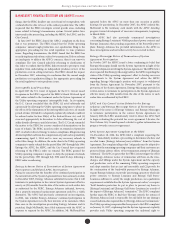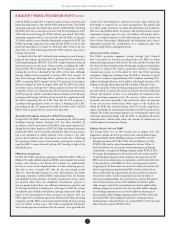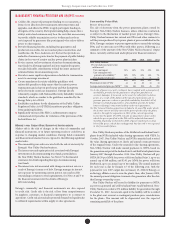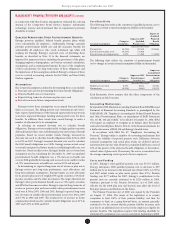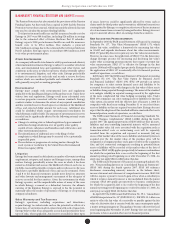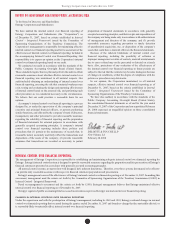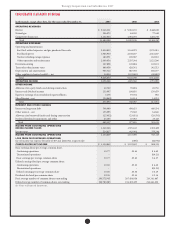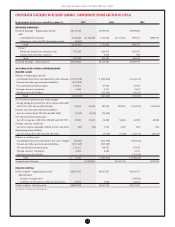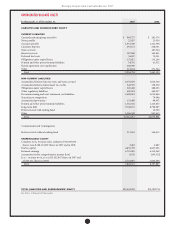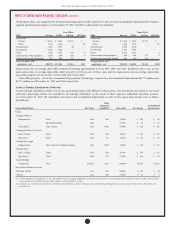Entergy 2007 Annual Report Download - page 53
Download and view the complete annual report
Please find page 53 of the 2007 Entergy annual report below. You can navigate through the pages in the report by either clicking on the pages listed below, or by using the keyword search tool below to find specific information within the annual report.
51
Entergy Corporation and Subsidiaries 2007
The Pension Protection Act also extended the provisions of the Pension
Funding Equity Act that would have expired in 2006 had the Pension
Protection Act not been enacted, which increased the allowed discount
rate used to calculate the pension funding liability.
Total postretirement health care and life insurance benet costs for
Entergy in 2007 were $89.6 million, including $26 million in savings
due to the estimated eect of future Medicare Part D subsidies.
Entergy expects 2008 postretirement health care and life insurance
benet costs to be $93.4 million. is includes a projected
$24.7 million in savings due to the estimated eect of future Medicare
Part D subsidies. Entergy expects to contribute $69.6 million in 2008
to its other postretirement plans.
OT H E R CO N T I N G E N C I E S
As a company with multi-state domestic utility operations and a history
of international investments, Entergy is subject to a number of federal,
state, and international laws and regulations and other factors and
conditions in the areas in which it operates, which potentially subject
it to environmental, litigation, and other risks. Entergy periodically
evaluates its exposure for such risks and records a reserve for those
matters which are considered probable and estimable in accordance
with generally accepted accounting principles.
Environmental
Entergy must comply with environmental laws and regulations
applicable to the handling and disposal of hazardous waste. Under these
various laws and regulations, Entergy could incur substantial costs
to restore properties consistent with the various standards. Entergy
conducts studies to determine the extent of any required remediation
and has recorded reserves based upon its evaluation of the likelihood
of loss and expected dollar amount for each issue. Additional sites
could be identied which require environmental remediation for
which Entergy could be liable. e amounts of environmental reserves
recorded can be signicantly aected by the following external events
or conditions:
n Changes to existing state or federal regulation by governmental
authorities having jurisdiction over air quality, water quality,
control of toxic substances and hazardous and solid wastes, and
other environmental matters.
n e identication of additional sites or the ling of other
complaints in which Entergy may be asserted to be a potentially
responsible party.
n e resolution or progression of existing matters through the
court system or resolution by the United States Environmental
Protection Agency (EPA).
Litigation
Entergy has been named as defendant in a number of lawsuits involving
employment, ratepayer, and injuries and damages issues, among other
matters. Entergy periodically reviews the cases in which it has been
named as defendant and assesses the likelihood of loss in each case as
probable, reasonably estimable, or remote and records reserves for cases
which have a probable likelihood of loss and can be estimated. Notes
2 and 8 to the nancial statements include more detail on ratepayer
and other lawsuits and management’s assessment of the adequacy of
reserves recorded for these matters. Given the environment in which
Entergy operates, and the unpredictable nature of many of the cases
in which Entergy is named as a defendant, however, the ultimate
outcome of the litigation Entergy is exposed to has the potential to
materially aect the results of operations of Entergy, or its operating
company subsidiaries.
Sales Warranty and Tax Reserves
Entergy’s operations, including acquisitions and divestitures,
require Entergy to evaluate risks such as the potential tax eects of a
transaction, or warranties made in connection with such a transaction.
Entergy believes that it has adequately assessed and provided for these
types of risks, where applicable. Any reserves recorded for these types
of issues, however, could be signicantly aected by events such as
claims made by third parties under warranties, additional transactions
contemplated by Entergy, or completion of reviews of the tax treatment
of certain transactions or issues by taxing authorities. Entergy does not
expect a material adverse eect on earnings from these matters.
NE W AC C O U N T I N G PR O N O U N C E M E N T S
In September 2006 the FASB issued Statement of Financial Accounting
Standards No. 157, “Fair Value Measurements” (SFAS 157), which
denes fair value, establishes a framework for measuring fair value
in GAAP, and expands disclosures about fair value measurements.
SFAS 157 generally does not require any new fair value measurements.
However, in some cases, the application of SFAS 157 in the future may
change Entergy’s practice for measuring and disclosing fair values
under other accounting pronouncements that require or permit fair
value measurements. SFAS 157 is eective for Entergy in the rst
quarter 2008 and will be applied prospectively. Entergy does not expect
the application of SFAS 157 to materially aect its nancial position,
results of operations, or cash ows.
In February 2007 the FASB issued Statement of Financial Accounting
Standards No. 159, “e Fair Value Option for Financial Assets
and Financial Liabilities” (SFAS 159). SFAS 159 provides an option
for companies to select certain nancial assets and liabilities to be
accounted for at fair value with changes in the fair value of those assets
or liabilities being reported through earnings. e intent of the standard
is to mitigate volatility in reported earnings caused by the application
of the more complicated fair value hedging accounting rules. Under
SFAS 159, companies can select existing assets or liabilities for this fair
value option concurrent with the eective date of January 1, 2008 for
companies with scal years ending December 31 or can select future
assets or liabilities as they are acquired or entered into. Entergy does not
expect that the adoption of this standard will have a material eect on its
nancial position, results of operations, or cash ows.
e FASB issued Statement of Financial Accounting Standards No.
141(R), “Business Combinations” (SFAS 141(R)) during the fourth
quarter 2007. e signicant provisions of SFAS 141R are that: (i) assets,
liabilities and non-controlling (minority) interests will be measured
at fair market value; (ii) costs associated with the acquisition such as
transaction-related costs or restructuring costs will be separately
recorded from the acquisition and expensed as incurred; (iii) any
excess of fair market value of the assets, liabilities and minority interests
acquired over the fair market value of the purchase price will be
recognized as a bargain purchase and a gain recorded at the acquisition
date; and (iv) contractual contingencies resulting in potential future
assets or liabilities will be recorded at fair market value at the date of
acquisition. SFAS 141(R) applies prospectively to business combinations
for which the acquisition date is on or aer the beginning of the rst
annual reporting period beginning on or aer December 15, 2008. An
entity may not apply SFAS 141(R) before that date.
e FASB issued Statement of Financial Accounting Standards No.
160, “Noncontrolling Interests in Consolidated Financial Statements”
(SFAS 160) during the fourth quarter 2007. SFAS 160 enhances
disclosures surrounding minority interests in the balance sheet,
income statement and statement of comprehensive income. SFAS 160
will also require a parent to record a gain or loss when a subsidiary in
which it retains a minority interest is deconsolidated from the parent
company. SFAS 160 applies prospectively to business combinations
for which the acquisition date is on or aer the beginning of the rst
annual reporting period beginning on or aer December 15, 2008. An
entity may not apply SFAS 160 before that date.
In April 2007 the FASB issued Sta Position No. 39-1, “Amendment
of FASB Interpretation No. 39” (FSP FIN 39-1). FSP FIN 39-1 allows an
entity to oset the fair value of a receivable or payable against the fair
value of a derivative that is executed with the same counterparty under
a master netting arrangement. is guidance becomes eective for scal
years beginning aer November 15, 2007. Entergy does not expect these
provisions to have a material eect on it its nancial position.
Management’s Financial Discussion and Analysis concluded





